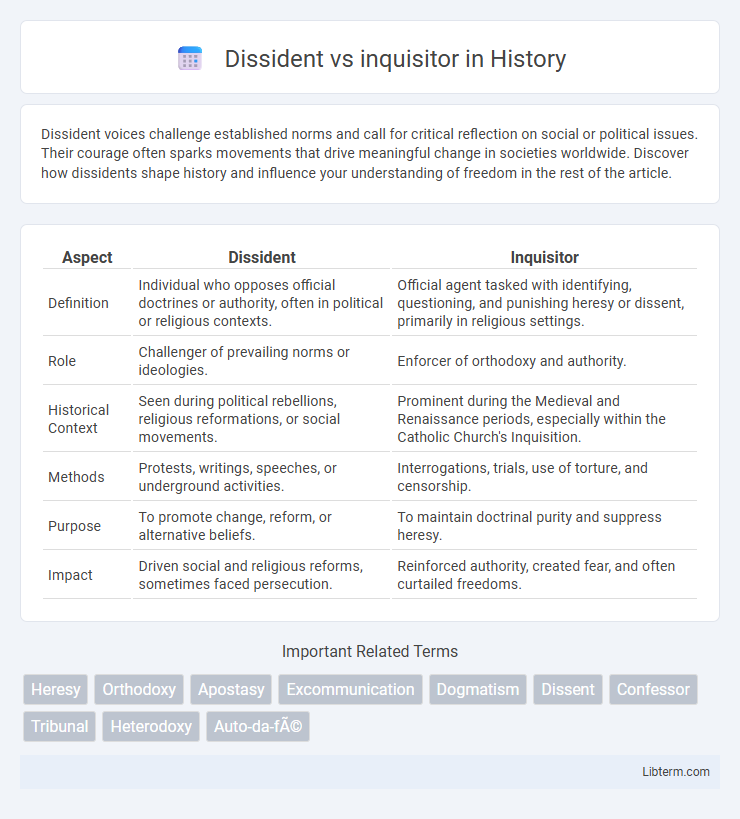Dissident voices challenge established norms and call for critical reflection on social or political issues. Their courage often sparks movements that drive meaningful change in societies worldwide. Discover how dissidents shape history and influence your understanding of freedom in the rest of the article.
Table of Comparison
| Aspect | Dissident | Inquisitor |
|---|---|---|
| Definition | Individual who opposes official doctrines or authority, often in political or religious contexts. | Official agent tasked with identifying, questioning, and punishing heresy or dissent, primarily in religious settings. |
| Role | Challenger of prevailing norms or ideologies. | Enforcer of orthodoxy and authority. |
| Historical Context | Seen during political rebellions, religious reformations, or social movements. | Prominent during the Medieval and Renaissance periods, especially within the Catholic Church's Inquisition. |
| Methods | Protests, writings, speeches, or underground activities. | Interrogations, trials, use of torture, and censorship. |
| Purpose | To promote change, reform, or alternative beliefs. | To maintain doctrinal purity and suppress heresy. |
| Impact | Driven social and religious reforms, sometimes faced persecution. | Reinforced authority, created fear, and often curtailed freedoms. |
Understanding the Terms: Dissident and Inquisitor
A dissident is an individual who actively challenges established authority, often opposing political or ideological norms, while an inquisitor is a figure who enforces conformity through investigation and interrogation, historically linked to institutions like the Spanish Inquisition. Understanding dissidents involves recognizing their role in advocating for change or reform, whereas inquisitors are associated with maintaining control and suppressing dissent. The dynamic between these terms highlights the tension between resistance and enforcement within social and political contexts.
Historical Origins of Dissidents and Inquisitors
Dissidents originated as individuals or groups opposing established religious, political, or social doctrines, notably during the Reformation and Enlightenment periods, challenging institutions like the Catholic Church and monarchies. Inquisitors emerged from the medieval Catholic Church's formalized judicial system, particularly the Papal Inquisition established in the 12th century, tasked with identifying and prosecuting heresy to maintain doctrinal purity. The historical clash between dissidents and inquisitors reflects the broader conflict between reformist ideas and institutional authority rooted in medieval Europe's evolving religious and political landscape.
Core Philosophies: Dissent Versus Inquisition
Dissidents champion individual freedom, critical thinking, and the challenge of established norms to promote social progress and truth. Inquisitors prioritize authority, conformity, and the suppression of dissent to maintain order and control within a society. The core philosophical conflict between dissent and inquisition revolves around liberty versus power, where dissent fuels innovation and inquisitors enforce orthodoxy through coercion.
Roles in Society: Challenging vs. Enforcing Orthodoxy
Dissidents serve as catalysts for social change by challenging established norms and questioning dominant ideologies, often risking marginalization to promote alternative viewpoints. Inquisitors uphold societal orthodoxy by enforcing conformity through mechanisms of control, investigation, and punishment aimed at suppressing dissent and preserving ideological unity. The dynamic between dissidents and inquisitors shapes cultural evolution by balancing innovation against institutional stability.
Methods and Tactics: Voice of Opposition vs. Tools of Control
Dissidents employ methods such as peaceful protests, underground publications, and digital activism to amplify their voice of opposition, challenging authority and exposing injustice. Inquisitors rely on tools of control like surveillance, censorship, intimidation, and interrogation to suppress dissent and maintain power. The clash between dissidents' resilience and inquisitors' coercive tactics defines the struggle for freedom and control in contested political spaces.
Famous Dissidents and Notorious Inquisitors
Famous dissidents such as Nelson Mandela and Vaclav Havel challenged oppressive regimes and inspired global movements for freedom and human rights, symbolizing resilience against authoritarianism. Notorious inquisitors, including Tomas de Torquemada and Heinrich Kramer, instigated brutal religious persecutions during the Spanish Inquisition and witch trials, reinforcing fear and control through torture and executions. The historical impact of these figures underscores the struggle between ideological resistance and institutional oppression.
Impact on Social and Political Change
Dissidents challenge established power structures by promoting alternative ideologies and exposing injustices, often sparking grassroots movements that drive social and political reform. Inquisitors enforce orthodoxy and suppress dissent through legal and ideological mechanisms, aiming to maintain existing hierarchies and prevent societal upheaval. The dynamic between dissident activism and inquisitorial repression significantly shapes the trajectory of political change and cultural transformation in societies worldwide.
Ethical Dimensions: Morality of Dissent and Investigation
Dissidents challenge established norms by advocating for ethical principles such as justice, equality, and transparency, often risking personal safety to expose corruption and human rights violations. In contrast, inquisitors operate with authority to enforce conformity and maintain order, but their investigations can breach moral boundaries when methods involve coercion, deception, or punishment without fair trial. The ethical complexity lies in balancing the dissident's moral duty to dissent against the inquisitor's role in safeguarding societal norms without infringing on individual freedoms.
Modern Manifestations: Dissidents and Inquisitors Today
Modern manifestations of dissidents often appear in digital activism, challenging authoritarian regimes through online platforms using encrypted communication and social media. Inquisitors today frequently manifest as state surveillance agencies and misinformation operatives enforcing ideological conformity by monitoring dissent and restricting free speech. The dynamic between digital dissidents and institutional inquisitors shapes contemporary debates on human rights, privacy, and governmental control worldwide.
Societal Outcomes: Progress or Repression
The conflict between dissidents and inquisitors significantly shapes societal outcomes by either fostering progress or enforcing repression. Dissidents challenge prevailing norms, promoting innovation, human rights, and social reforms, while inquisitors often suppress dissent through censorship and coercion, maintaining authoritarian control. Societies dominated by inquisitorial forces tend to experience stagnation and fear, whereas those embracing dissident voices generally advance toward greater freedom and cultural evolution.
Dissident Infographic

 libterm.com
libterm.com